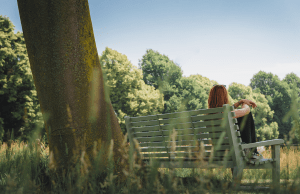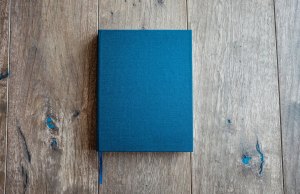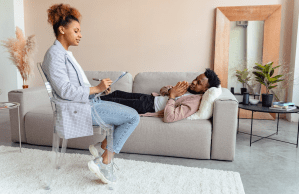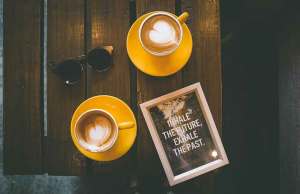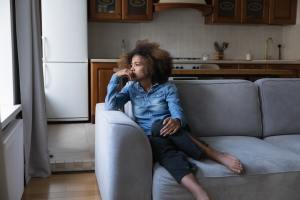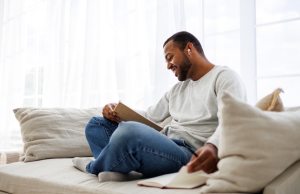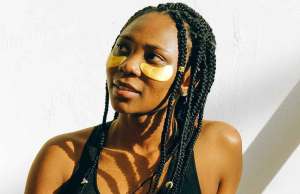
- Stress, poor sleep, and a shortage of alone-time can all be creativity killers–and it’s a rare artist who doesn’t feel stuck, frustrated, or burnt-out right now.
- But the creative brain is characterized by its ability to widen its perceptual field and invite new experiences.
- The creative brain draws meaning from life by making uninhibited connections between disparate sources of information.
- Artistic burnout has been especially hard on parents, but they can begin to heal through self-compassion, revising their creative processes, and making accommodations for the messiness of life.
- If you’re an artist with a toddler, invest in a salad spinner and a spray bottle.
For every Taylor Swift flourishing artistically during the pandemic, there are millions of suffering and burnt-out people who aren’t composing songs or painting portraits or writing novels. What have they been doing instead? Well, if they’re anything like me, they’ve been drowning in domestic labor, work, anxiety, childcare, and other daily demands on their time and attention. Art production and creativity have taken a backseat to dependents, escapist entertainment, doomscrolling, alcohol, paying bills, depression, life-and-death decisions, self-loathing, cynicism, dishwashing… On most days, I’m barely holding it together as a person, let alone as an artist or a parent. On my best days, I’m in the grandmother phase of caretaking: I provide lots of love, but also plenty of candy and Netflix. Because I’m tired. I don’t feel that I can do more than I’m doing.
But that’s changed recently. I’ll spare you the long, lyrical essay about my own creative death and rebirth. This is not the forum. Instead, I’ll give you practical, concrete tips for getting inspired again. I think the advice should apply whether you’re a Big-C creative or a little-c creative, whether you’re childless or you answer to “Mom” or “Dad”, whether your creative domain is visual art, poetry, music, comedy, or taxidermy.
First, let’s explore the psychology behind our creativity. Then we can talk more about Taylor Swift, as well as art saints and gorillas in the living room.
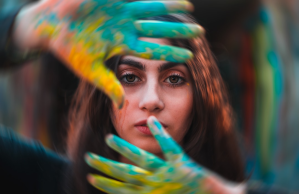
What Influences Our Creativity?
In psychological studies, the dominant personality trait of a creative person is openness to experience. This means that creative people are more receptive to novelty: new ideas, new places, new perspectives. Psychometric studies show this characteristic again and again. Creative people are curious about the world and feel driven to explore it. Their brains have more plasticity, meaning more openness, more extraversion, and higher energy.
The creative person doesn’t have as many cognitive filters in place when they take in their surroundings. They don’t automatically dismiss information or stimuli that someone else might deem insignificant. Therefore they have access to more raw material, which they can readily draw on to forge new meaning.
This all might sound vague, but it’s backed up by hard neuroscience. The process of cognitive exploration is facilitated by a robust dopamine network, the brain’s chemical reward system. The creative brain can easily toggle between a song on the radio to a memory of a childhood pet to the theory of relativity, making discoveries with minimal cognitive inhibition. Then when this generative period ends, the creative brain can switch gears, beginning the process of convergence–selecting and combining what’s relevant, recognizing patterns–so the end result is an “ideational mutation”. In other words, something new is born.
Some researchers call this process blind variation and selective retention (BVSR). Some divide creativity into distinct stages: preparation, incubation, illumination, and verification. Some point to default networks, salience networks, and executive networks in the brain. But the bottom line is that the creative brain is more flexible, able to activate and deactivate different networks/cognitive stages at will, task-switching between diverse modes of thought.
Once we learn the full machinery of the creative brain, it stands to reason that we’d be able to help or hinder the artistic process. And scientists do know a lot about how different phenomena affect creativity. The following elements can influence how freely ideas will dance around in our heads:
- Stress. When people are stressed, their creativity suffers. Their mental resources need to go toward defending the body and mind, not integrating information. Cognitive networks can communicate better with lower levels of stress hormones. Anxiety is also associated with reduced creative performance.
- Coffee. Caffeine can have a detrimental effect on creativity by making it harder to fall asleep and by “dulling your ability to think more diffusely”.
- Sleep. Good sleep seems to be essential to the creative brain. The REM and the non-REM sleep phases work together to form new connections and solve problems.
- Alcohol. Modest amounts of alcohol can facilitate the first stages of the creative process, but not the final stages. Many creative people testify to being less sensitive and aware when inebriated, which can inhibit their art.
- Genetics. The big 5 personality trait openness to experience shows a high degree of heritability, as does motivation. There are some candidate genes for creativity, and there may be some genetic mutations implicated in the creative spark (these mutations are also associated with mental illness, but that’s another article).
- Mood. So-called activating moods like anger, fear, happiness, and elation can enhance creativity, while deactivating moods (sadness, depression, relaxation, and sereneness) lead to avoidance. This is because high emotional arousal can be converted into creative energy.
- Distraction. Being distracted can help foster certain creative processes, especially in older adults.
- Social labeling. You can encourage someone’s creativity simply by calling them an artist. Which makes you wonder if certain culturally-loaded labels like “mother” could have an enervating effect.
- Society. People tend to be more creative in a multiethnic, ideologically diverse civilization.
- Socio-economics. Though having offspring is normally cognitively enriching, research shows that taking away a mother rat’s critical resources (food, shelter, etc.) impairs her neuroplasticity.
- Experience. Creative people have often experienced adversity, crises, or extreme positive events. These “diversifying experiences” can encourage cognitive flexibility by making people adapt to extraordinary circumstances.
So on the one hand the pandemic has handed us a diversifying experience; on the other hand it’s made us vulnerable to chronic stress, substance abuse, financial difficulties, anxiety, and mood disorders. It’s a rare creative person who can emerge intact from all this drama.
What Is Creative Burnout?
Burnout is a psychological and occupational phenomenon defined by emotional exhaustion, cynicism, and a sense of incapacity. Creative or artistic burnout is similar, and perhaps especially painful because it can threaten your passion and identity. A burnt-out artist feels overwhelmed, depleted, blocked. Their well has run dry. They’re unfocused and ineffectual. And they’re not making art.
The author Jon Malesic often writes about how America’s Protestant ethic has misled people into defining their human worth by their work. Like Max Weber before him, Malesic thinks that “work anxiety is built into capitalism”. People are anxious to prove their human value to themselves and others by becoming “work saints”. I hazard to guess that many artists suffer right now because their creativity has become conflated with their creative production. Therefore when they fail to be art saints, generating books and paintings and albums, or they fall off the map a bit due to a pandemic, they experience creative burnout. It’s part of a problem that’s been described as creativity creep, where people are encouraged to get their creative juices flowing for the good of the market, not from intrinsic desire, or for their own mental health and wellbeing. Not because creativity is an end in itself, but because it churns out measurable and monetizable results.
Parenthood can sometimes make creativity seem like work, rather than a way of life. For caregivers during the pandemic, art might become one more task they need to do so they can sleep at night, knowing that they did everything. When you’re a mom, art is often something you have to schedule, which means you feel the burden of productivity. The necessity of treating art like work can lead to burnout: irritability, exhaustion, brain fog, simultaneous mental overload and underload.
The mind has to rebel against all that pressure. It’s no good to think of creativity as fragile and fragmented, finite and compartmentalized. We can develop dysfunctional relationships with art just as we can with work. Your kid is screaming in the other room, preventing you from finishing your creative task. You feel that you have nothing to show for yourself. But is that true?
“Creative burnout is not a fatality, it’s an injury.”
Nathalie Sejean
My Parasitic Relationship with Taylor Swift
Here’s how I imagine Taylor Swift’s day-to-day life: sleep late, make love to boyfriend, mess around with beautiful clothes, text friends and family, record songs, pet famous cats, read classic novels and rock star biographies, nap, bake zucchini muffins, knit leg warmers, daydream, drink wine, talk about art, make out with boyfriend, stay up all night writing more songs. For all these reasons, I bet Ms. Swift is absolutely petrified of having children.
I suppose a person could be jealous of Taylor Swift’s fame and money, but I’m honestly more jealous of her time. Here’s something I don’t envy, however: the role that extrinsic rewards seem to play in her creative life. When I recently watched her documentary Miss Americana, I was struck by how important accolades and album sales and public approval seemed to be in defining her self-worth as an artist. Maybe that’s changed. Status hunger seems like the purview of a 20-something TS, not a 30-something TS. But just last night Taylor felt that she had to defend her artistic reputation on Twitter, so who knows.
Creative brains produce a lot of ideas, which means that many of them will not be masterpieces. In fact, a number of them will be failures. That’s the process. It’s like Conan O’Brien says about show business: “You have to keep going back into the casino and pulling the lever.” Who would subject themselves to all this failure? To do so, you have to be intrinsically motivated. In fact, studies show that the motivational profile of an artist is defined by enjoyment in and of itself. Creativity is self-rewarding.
So I worry about Taylor Swift having kids. (Naturally I would like to be involved in this decision. I’m thoroughly invested at this point.) Before entering motherhood, shouldn’t Taylor develop the protective confidence to follow her own creative inspiration wherever it takes her without worrying about outside forces? But maybe that’s the lifelong endeavor of all artists.
“To be yourself in a world that is constantly trying to make you something else is the greatest accomplishment.”
Ralph Waldo Emerson
Less Time, More Meaning in the Domestic Arts
I cannot write a compound sentence without my daughter telling me she’s hungry. I cannot daydream about unicorns without someone asking me where they left their car keys/water bottle/L.O.L. Surprise doll hotpants. Many of today’s frustrated artists are also frustrated parents. Creativity requires childcare, especially during a pandemic. It’s hard to turn crisis into creative action when your kids are also in crisis, and they need you. As a conscientious parent, you don’t get the luxury of completely detaching. So you feel that you can’t fully inhabit your creative mind while putting your kid to bed at the same time every night.
In my Googling for this piece, I was thrilled to find a New Yorker article entitled “An Artist’s Guide to Raising Children”. Hallelujah! And then I realized it was a satire. Of course it was comedy, because what else can you do when the sharks are circling? I’ve concluded that no one can answer the important questions for me: As parents, how do we get the solitude that creativity requires? How do we carve out time to look inward? How do we achieve less noise, less boredom? (Doris Lessing once stated, “There is nothing more boring for an intelligent woman than to spend endless amounts of time with small children.” Just leaving that here.) I’m only beginning to figure this stuff out now that I have a school-aged, vaccinated kid, not a helpless baby. (By the way, parents: a child’s age matters. It will get easier.)
I haven’t been all that interested in reading the literature of domestic ambivalence, where moms chronicle their struggles to parent through creative failure and artists chronicle their struggles to art through parenting failure. These authors don’t need to defend the mundane to me. I get it. There’s a social bias that suggests the meaning parents forge in raising their kids is somehow less important or interesting in the grand hierarchy of meaning. But who decides what’s interesting? Raising kids connects parents to every human family that preceded them for 200,000 years. Personally, I no longer worry that I can’t do this or that specific art thing. Artists can use everything. And to those who would say, “But that’s not art,” I would say, “Take your immortality where you can get it.” Start by giving your art power. The time will follow.
“The most regretful people on earth are those who felt the call to creative work, who felt their own creative power restive and uprising, and gave to it neither power nor time.”
Mary Oliver
There’s a Gorilla in Your Home, and It May or May Not Be Your Child
In a famous psychological study, psychologists asked participants watching a video of a basketball game to keep track of the number of times one team passed the ball. During the game, a person in a gorilla suit wandered onto the court, thumped their chest, then departed. Only half the people watching the game noticed the gorilla. This is an example of inattentional blindness.
But creative people are more likely to notice the gorilla. Why? Because the creative brain is neurologically more porous, permitting more information into its field of perception. Maybe creative blocks are little more than perceptual blocks. Maybe you’ve become more selective about what enters your brain instead of opening your eyes, opening the gates, and embracing the full breadth of reality. Maybe you think art should look a certain way, and so you exclude whatever doesn’t conform to that notion.
Maybe your kid is the gorilla. Maybe the gorilla is the view outside your window, or the emotion you’ve been avoiding, or whatever. Perhaps you need to be willing to change your perspective, zoom in or zoom out, look at life through different eyes. Listen more deeply, examine more closely, face your berserk, chaotic household instead of mentally defending yourself against your childrens’ constant interruptions. Try to find meaning in the messiness.
“It is time now to explore the creative potential of interrupted and conflicted lives, where energies are not narrowly focused or permanently pointed toward a single ambition. These are not lives without commitment, but rather lives in which commitments are continually refocused and redefined.”
Mary Catherine Bateson
How to Fix What Covid Has Broken
Looking back at the past two years, I think it was my openness to experience that died, not my creativity per se. I became neophobic–scared of novelty. What killed my open mind (or at least my slightly ajar mind)? Well, I was anxious all the time, devouring the bad news, worrying about the world, worrying about my daughter. Newness represented danger. But what does it mean to be an uninhibited artist? Does that mean childless? Jobless? Where do the obstacles stop?
I think the first step to fixing what the Covid-19 pandemic has broken, especially for frustrated artists, is to acknowledge your suffering. You might not think the suffering of a storyteller or a painter can compare with the suffering of a frontline worker or the suffering of someone who’s been sick, or who has lost a loved one. But just as you can feel compassion for a friend in any kind of pain, you can feel compassion for yourself. Your way of being in the world has been harmed in so many ways. You’ve had to reorient, but it’s been stunted and painful, not the positive transformation that some people attest to (I’m looking at you, TS), and now you don’t know how to be.
From this place of compassion, you can try to rebuild. Here are some suggestions to nudge along a creative renaissance:
- Acknowledge that your phone addiction might just indicate that your creative mind still craves stimulation–a dopamine rush that’s much harder to get in isolation. Substitute something better.
- Marine biologists think that whales generate new songs in an effort to distinguish their social group. We do the same thing. Art is social. Creativity only arose in humans when we began living in dense societies. Find your people.
- Don’t get stuck feeling nostalgic for your old creative process. Find a new process.
- Remember that most artists get their training in other fields. They start by being “marginal”. For instance, a great actor can become a better actor by being a great bartender. Maybe you can become a better poet by getting really good at reading bedtime stories.
- Take a guilt-free nap whenever you can–not to avoid, but to recharge. For creative fuel you need both rest and new experiences, stimulus and boredom.
- Aim to learn something every day. Cultivate the wide interests and hobbies that often characterize creative people.
- Be persistent without obsessing about end results.
- If you’re a parent, keep an emergency bin on hand to keep your kids entertained just in case you find yourself in an artistic flow state. Suggestions for content: new toys from the Dollar Store, Smarties, coloring books, games, spray bottles, salad spinners, costume jewelry, blank comic book pages.
- In Julia Cameron’s bestselling “Artist’s Way” book series, Cameron encourages people to make “artist dates” for themselves once a week. This means making time to seek out something new, something that ignites you.
- Some studies show that random images–blind variations–can stimulate the creative mind, so if you’re feeling blocked, flip through art books–or your kids’ picture books.
- If you have kids, occasionally give them precisely 5 minutes of your undivided attention, when they can choose the “special time” activity. Then go back to what you were doing. It’s not the quantity of time that matters, it’s the quality.
- Work on reducing your anxiety levels with cognitive behavioral therapy (CBT).
- Don’t forget about music! (Confession: I forgot about music. Unless you count Encanto.)
- You have to eat dinner. In fact, you probably have to cook it yourself. So during the meal, challenge every family member to tell one funny story from their day. (Many artists cite the dinner table as their first creative platform.)
- Nature (duh). Time outside can help people avoid burnout and nourish their creativity.
- If you’re a selfless parent, use your nurturing drive as creative motivation. To grow up to be open-minded individuals, your children need to see you dancing, listening to music, getting excited about new ideas. They need to see you value your art, whatever form it takes. Do it for them, if not for yourself.
- Overcome your creative atychiphobia (fear of failure). Art requires risk. There’s a lot less at stake than you think.
- Be aware of how you might try to dull your sensitivity with alcohol. (Dry January was a turning point for me.)
- Stay informed, but not obsessed, with current events. Don’t get flooded. Try to use your fear and anger as a motivator.
- Write down your ideas, no matter how random or insubstantial they are. You’ll see how they add up and become a positive feedback loop.
- Many animals in captivity suffer from stereotypical behaviors and depression, aka zoochosis, but environmental enrichment has been shown to reduce their symptoms over 50% of the time. What would enrich your environment?
Another marker of the creative mind is its ability to host mixed emotions and mixed appraisals. For the creative person, two contradictory things can be true at the same time. The mind can contain multitudes. This means that you can absolutely recognize that the pandemic era has been awful, but also that it’s been meaningful. Give yourself permission to feel again. The most nurturing, generous thing you can do for this world and its children is to pay attention.
“Nothing you create is ultimately your own, yet all of it is you. Your imagination, it seems to me, is mostly an accidental dance between collected memory and influence, and is not intrinsic to you, rather it is a construction that awaits spiritual ignition….Worry less about what you make — that will mostly look after itself, and is to some extent beyond your control, and perhaps even none of your business — and devote yourself to nourishing this animating spirit.”
Nick Cave
